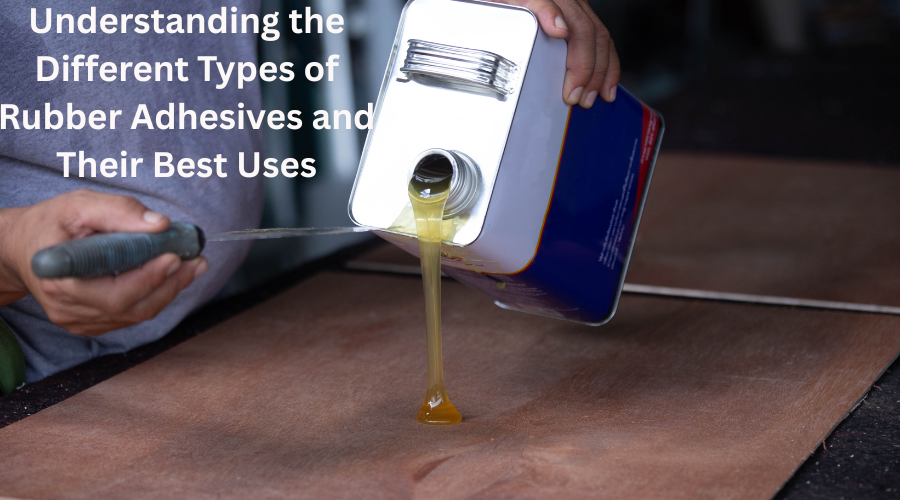Understanding the Different Types of Rubber Adhesives and Their Best Uses
- qinglongdatech
- May 8
- 5 min read

When it comes to bonding materials in a wide range of industries, rubber adhesives play a crucial role. Whether you're in the automotive, construction, or electronics industry, these adhesives provide a reliable solution for creating strong, durable bonds. With a variety of types and formulations available, it's important to understand the differences and know which one suits your needs best. In this blog, we'll dive deep into the world of rubber adhesives, their types, uses, and how to choose the right one for your application. Additionally, we'll highlight some important factors to consider when selecting from rubber adhesive suppliers.
What Are Rubber Adhesives?
Rubber adhesives are a category of adhesives that primarily consist of natural or synthetic rubber. They are designed to bond different materials, offering flexibility, strength, and durability against environmental conditions. These adhesives are unique because they retain their elasticity even after curing, which makes them ideal for applications where the bonded materials might be subjected to movement or stress.
The primary benefit of rubber adhesives is their ability to bond materials with different characteristics, such as metals, plastics, textiles, and glass. These adhesives are commonly used in industries like automotive, construction, electronics, packaging, and more.
Types of Rubber Adhesives
There are several types of rubber adhesives, each suited to specific applications. The most common types include:
1. Natural Rubber Adhesives
As the name suggests, natural rubber adhesives are derived from the latex of rubber trees. These adhesives are known for their high elasticity, excellent bonding strength, and versatility. Natural rubber adhesives are widely used in applications that require a flexible, long-lasting bond.
Best Uses:
Automotive industry: For bonding parts that are subject to vibrations or movement.
Footwear: Ideal for bonding rubber soles to shoe uppers.
Packaging: For sealing boxes and packages that require a strong bond without stiffness.
2. Synthetic Rubber Adhesives
Synthetic rubber adhesives are made from artificial rubber compounds, which are created through chemical processes. These adhesives often offer superior strength and tolerance to environmental conditions like heat, moisture, and chemicals compared to natural rubber adhesives.
Best Uses:
Electronics: For bonding components that must withstand heat and moisture.
Construction: Ideal for bonding materials that are exposed to harsh weather conditions.
Automotive: Used in applications requiring resistance to high temperatures and oils.
3. Butyl Rubber Adhesives
Butyl rubber adhesives are a subcategory of synthetic rubber adhesives. They are made from a blend of isobutylene and isoprene, and they are known for their excellent resistance to air, moisture, and gases. This makes them a great choice for applications in which environmental factors like weather, temperature, and humidity might affect the bond.
Best Uses:
Roofing: For sealing gaps and joints in roofing systems.
Automotive: Ideal for bonding weather stripping and sealing parts of cars and trucks.
Aerospace: Used in applications where resistance to air and moisture is crucial.

4. Neoprene Rubber Adhesives
Neoprene is another synthetic rubber that is widely used in adhesives. It has outstanding durability to heat, chemicals, and weathering, making it highly versatile in many industries. Neoprene rubber adhesives are strong, flexible, and can bond a wide range of materials.
Best Uses:
Marine: For bonding materials in boats and other watercraft.
Construction: Ideal for use in gaskets, seals, and flooring adhesives.
Electrical: Used in applications requiring insulation and resistance to temperature extremes.
5. Silicone Rubber Adhesives
Silicone rubber adhesives are made from silicone-based compounds, which are known for their high-temperature resistance and flexibility. These adhesives are excellent for applications that involve extreme temperatures or the need for waterproofing.
Best Uses:
Electronics: To bond sensitive electronic components that may need to withstand high heat.
Automotive: Used for sealing engine parts that are exposed to extreme temperatures.
Construction: Ideal for windows, doors, and roofing systems due to their waterproofing properties.
6. Acrylic Rubber Adhesives
Acrylic rubber adhesives are based on acrylic resins combined with rubber polymers. These adhesives offer a strong bond with fast curing times and excellent resistance to UV light,turning them into the best choice for both indoor and outdoor applications.
Best Uses:
Outdoor signage: For adhering decals, posters, or signs that are exposed to sunlight.
Automotive: Bonding trim, moldings, and weatherstripping.
Construction: Adhesion of flooring materials and wall coverings in areas that receive a lot of natural light.
Factors to Consider When Choosing a Rubber Adhesive
When selecting a rubber adhesive, numerous factors should be evaluated to confirm you choose the right product for your application:
1. Bonding Strength
The strength of the bond is critical for the application. Some adhesives are designed for high-strength bonding, while others offer moderate strength with flexibility. Always assess the materials you are working with and the stress they will undergo.
2. Temperature Resistance
If the connected materials will be exposed to extreme temperatures, it's essential to choose an adhesive that can withstand those conditions. Neoprene, silicone, and butyl rubber adhesives are great options for high-temperature applications.
3. Environmental Resistance
Consider the environmental conditions the adhesive will face. If moisture, chemicals, or UV exposure is a concern, look for adhesives designed to provide excellent resistance to these elements.
4. Curing Time
Some rubber adhesives cure quickly, while others take longer to set. If you need fast results, look for an adhesive with a short curing time. Conversely, if you're working on a more complex project, a longer curing time might give you more flexibility.
5. Application Method
The usage method can vary depending on the type of rubber adhesive. Some require a specific application tool, while others can be applied directly by hand. Ensure you understand the process of applying the adhesive effectively.
Where to Buy Rubber Adhesives
When it comes to purchasing rubber adhesives, it's important to buy from reputable supplier who offer high-quality products suited for your needs. Do your research to find a supplier that provides technical data, support, and a range of adhesive options suitable for your project.
Conclusion
In summary, rubber adhesives are versatile, durable, and effective for bonding a wide range of materials across various industries. Whether you choose natural rubber, synthetic rubber, butyl rubber, neoprene, silicone, or acrylic, each type has specific advantages depending on the application. When selecting a rubber adhesive, consider the factors such as bonding strength, temperature resistance, environmental conditions, and curing time to ensure the best results. By partnering with a trusted supplier, you can ensure that you're using the right adhesive for your needs, leading to long-lasting and reliable bonds.
FAQs
1. What distinguishes Organic and artificial rubber adhesives?
Natural rubber adhesives are made from latex harvested from rubber trees, while synthetic rubber adhesives are chemically produced. Synthetic rubber adhesives typically offer greater resistance to environmental factors like heat and moisture.
2. Can rubber adhesives be used outdoors?
Yes, rubber adhesives like neoprene, silicone, and butyl rubber adhesives are ideal for outdoor applications due to their resistance to UV light, moisture, and temperature changes.
3. How long does it take for rubber adhesives to cure?
The curing time varies by adhesive type. Some rubber adhesives cure within minutes, while others may take several hours. Always check the product specifications for curing times.
4. Are rubber adhesives waterproof?
Certain types, such as butyl rubber adhesives and silicone rubber adhesives, are highly resistant to water and can provide a waterproof bond. Always verify the adhesive's specifications to ensure it meets your needs.
5. Can rubber adhesives be used in high-temperature applications?
Yes, adhesives like neoprene and silicone rubber adhesives are designed to withstand high temperatures, making them appropriate for automotive, aerospace, and industrial applications.
By choosing the right type of rubber adhesive for your project, you can attain a durable connection.







Comments